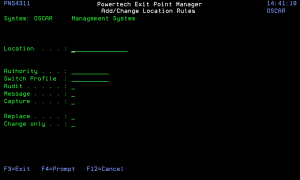How to Get There
Enter option 3 on the Exit Point Manager Main Menu to display the Work with Security by Location panel. Press F2 to display the Add Location Rules panel.
What it Does
The Global Rule Facility panel allows you to create location rules for all Servers.
Options
These rules will have a Function of *ALL.
System
System indicates the target of any operations you perform. When you add rules, for example, those rules will be sent to, and will affect processing on, the System named.
Location
Location represents the source of a transaction. Location can hold an IP Address, an IP Address Group or the name of an SNA Communications Device.
The special value *ALL, when used on a rule, means that the rule applies to any Location lacking a specific rule. When used as a subset or selection parameter, *ALL generally means to select all such rules for display or printing.
Server
A Server in Exit Point Manager is a controlled entry point into your system. These entry points are determined and defined by IBM. Exit Point Manager has assigned easy-to-remember names to these controlled entry points.
Function
A Function, or Server Function, in Exit Point Manager represents a class of operations that a given Server may perform. For example, the *SIGNON Server classifies its operations as those pertaining to changing passwords, generating authentication tokens, and retrieving signon information. Exit Point Manager has assigned easy-to-remember names to these Functions, such as CHGPWD, GENAUTTKN and RETRIEVE.
Authority Property
The authority assigned for servers and their functions.
Possible values are:
Switch Profile Property
The name of a switch profile for this location/server/function. If a profile name is supplied, processing is swapped to run under this profile's authority. This is only valid for authorities *SWITCH and *MEMSWITCH.
Possible values are:
Audit Property
The audit property controls the type of requests Exit Point Manager will log.
Possible values are:
Exit Point Manager will not change the existing settings and will not create new rules when the All Servers option is taken. This is valid for both location and user.
Message
The message property entry will determine if Exit Point Manager sends a message to the Exit Point Manager message queue.
Possible values are:
Capture
Capture transactions for Memorized Transaction Request (MTR).
Possible values are:
Change existing
The Change existing option controls whether any existing rules are updated or not updated.
The valid values are Y and N.
Change only
If this is set to 'N' then new rules are added and (depending on the setting for Replace) existing rules are changed.
If this is set to 'Y' then only existing rules are changed.
The valid values are Y and N.
